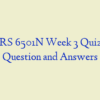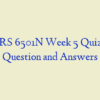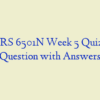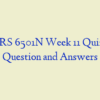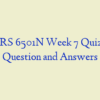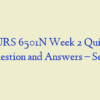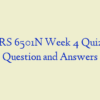Description
NURS 6501N Week 8 Quiz Advanced Pathophysiology (35 out of 35 points )
- Acute pancreatitis often manifests with pain to which of the following regions?
- For the patient experiencing esophageal reflux, the nurse would expect which sphincter to be malfunctioning?
- The nurse assessing the patient with biliary atresia would expect to find which primary clinical manifestation?
- A 50-year-old male is experiencing reflux of chyme from the stomach. He is diagnosed with gastroesophageal reflux. This condition is caused by:
- Cholecystitis is inflammation of the gallbladder wall usually caused by:
- Marasmus is most common in children of which age group?
- In alcoholic cirrhosis, hepatocellular damage is caused by:
- An 8-week-old male was recently diagnosed with cystic fibrosis. Which of the following digestive alterations would be expected?
- A 13-year-old female confides to her mother that she binge eats and induces vomiting to prevent weight gain. This disease is referred to as:
- The exocrine portion of the pancreas contains:
- A 10-month-old is brought to the pediatrician by the mother who states the baby has been experiencing colicky pain followed by vomiting, sweating, nausea, and irritability. Testing reveals a condition in which one part of the intestine telescopes into another. From which type of intestinal obstruction is he suffering?
- A 24-year-old male who sustained a head injury and fractured femur develops a stress ulcer. A common clinical manifestation of this ulcer is:
- A 60-year-old male presents with GI bleeding and abdominal pain. He reports that he takes NSAIDs daily to prevent heart attack. Tests reveal that he has a peptic ulcer. The most likely cause of this disease is:
- Manifestations associated with hepatic encephalopathy from chronic liver disease are the result of:
- A 27-year-old male presents with fever, GI bleeding, hepatomegaly, and transient joint pain. He reports that as a child he received blood transfusions following a motor vehicle accident. He also indicates he was vaccinated against hepatitis B. Which of the following types of hepatitis does the clinician think he most likely has? nurs 6501n week 8
- A 55-year-old female has general symptoms of gallstones but is also jaundiced. IV cholangiography would most likely reveal that the gallstones are obstructing the:
- Early identification and treatment for metabolic disorders is important because:
- The cardinal sign of pyloric stenosis caused by ulceration or tumors is:
- A 40-year-old female presents complaining of pain near the midline in the epigastrium. Assuming the pain is caused by a stimulus acting on an abdominal organ, the pain felt is classified as:
- Which of the following characteristics is associated with an acute occlusion of mesenteric blood flow to the small intestine?
- A 20-year-old male was recently diagnosed with lactose intolerance. He eats an ice cream cone and develops diarrhea. His diarrhea can be classified as _____ diarrhea.
- Reflux esophagitis is defined as a(n):
- The primary complication of enterocolitis associated with Hirschsprung disease is related to which finding? nurs 6501n week 8
- A 2-month-old female with Down syndrome is diagnosed with Hirschsprung disease following family complaints of chronic constipation. The most likely cause of these symptoms is:
- A 1-week-old female is brought to her pediatrician for abdominal distention and unstable temperature. Physical examination reveals bradycardia and apnea. Tests reveal hypoxic injury to the bowel resulting in bacterial invasion and perforation. This condition is referred to as:
- A 6-month-old male infant is brought to the ER after the sudden development of abdominal pain, irritability, and vomiting followed by passing of “currant jelly” stool. Ultrasound reveals intestinal obstruction in which the ileum collapsed through the ileocecal valve and invaginated into the large intestine. This type of obstruction is referred to as:
- The cardinal signs of small bowel obstruction are:
- Outbreaks of hepatitis _____ often occur in young children attending day care centers and can be attributed to poor hand washing.
- Which of the following symptoms would help a health care provider distinguish between ulcerative colitis and Crohn disease?
- Chronic gastritis is classified according to the:
- Kwashiorkor is a severe dietary deficiency of:
- A 3-month-old female develops colicky pain, abdominal distention, and diarrhea after drinking cow’s milk. The best explanation for her symptoms is:
- A 22-year-old male underwent brain surgery to remove a tumor. Following surgery, he experienced a peptic ulcer. His ulcer is referred to as a(n) _____ ulcer.
- The most common clinical manifestation of portal hypertension is _____ bleeding. nurs 6501n week 8
- An 8-week-old female is diagnosed with a congenital heart disease and Down syndrome. Her parents report that she has difficulty defecating. X-ray reveals anorectal malformation that causes complete obstruction often referred to as:



